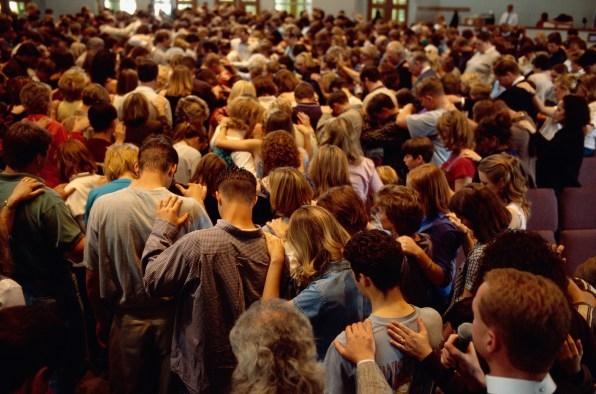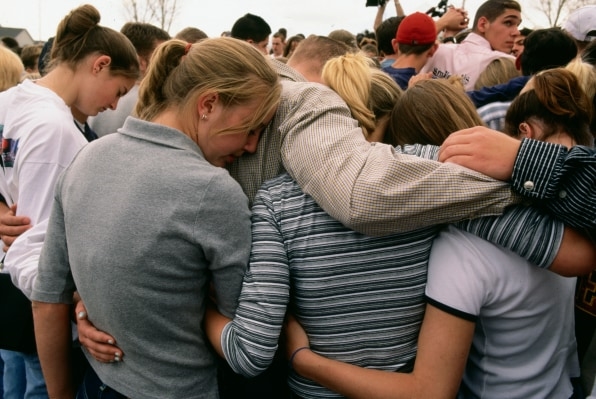First come the hashtags.
A location trending on Twitter might just refer to a college basketball team’s victory, but it also might mean the unthinkable has happened again–although by now, high school shootings are firmly rooted in the realm of the thinkable.
Click on the hashtag and find out What We Know So Far. How many were wounded, how many killed? Is it a record-setting number? How many students, how many faculty? Did the shooter take his own life–it’s always a his–or did the police get him? Keep in mind that the first wave of information is rarely accurate when gauging how somber to feel. Wade through the thoughts and prayers and ideological finger pointing and try to discern how tragic this event will register on the sliding scale of national tragedy, and how many days until most of us quietly agree to pretend it never happened.
It wasn’t always like this, of course. When the first truly unthinkable school shooting happened in Littleton, Colorado, 20 years ago today, a lot of people didn’t find out about it until hours later. There were no smartphones. People didn’t routinely hang out all day on the internet, rooting out the latest news like truffle pigs. You had to have been watching daytime CNN or getting a phone call, probably on a landline, from someone else who had been. Literal word of mouth. But for as long as it took everyone to catch up to what happened at Columbine High, the more glaring difference between then and now is what happened next.
The massacre at Columbine was a seismic news event. Nobody knew how to process it, including the press. School shootings had happened before–one in Springfield, Oregon’s Thurston High School the previous year had left two dead–but never on this scale. There was no media playbook for how to cover the slaughter of 12 students and one teacher, with a lingering bomb threat to boot. Such things simply didn’t happen. So once one did happen, the story didn’t go away after a few days or even weeks. It went on and on.
The Denver Post published articles about Columbine every single day for months on end, with the national papers and nightly news shows trailing not so far behind. Some of the nonstop coverage may have been driven by if-it-bleeds-it-leads sensationalism, but something else was at play: a struggle within the nation’s very soul. It was as if everyone feared that the moment the media stopped reporting on this shocking event, it would cease to be shocking, and we’d lose our humanity.

[Photo: David Butow/Corbis via Getty Images]
The initial wave of stories focused on the most urgent question: What exactly happened? (The why would come later.) As authorities uncovered the facts, tick-tock pieces began to appear, like one in USA Today with the headline, “The day innocence died: It began with a chilling prophecy.” Others offered readers suggestions on where to donate, and documented local businesses stepping in to lend a hand. “As shock fades, calls for help grow,” read one Denver Post headline, in a story about the community struggle to make funeral arrangements and find qualified grief counselors.
As the days went by, reporters focused more on the impact the attack had on students, teachers, and Littleton as a whole. A Los Angeles Times story on April 23 looked into how the town’s caretakers also needed care in the wake of the shooting. “Emergency workers and SWAT team members who first ventured into the high school’s blood-soaked library are starting to seek grief therapy,” the article read. “The therapists, in turn, are themselves getting help . . . fatigue from the long hours and grief from absorbing the town’s sadness has begun to take its toll.”
The Denver Post’s reporting eventually revealed that those who weren’t sufficiently consoled by therapists sought solace in church. A July story quoted an area priest saying that attendance had become “like Easter Sunday every week.”
National interest in Columbine stood at a fever pitch. Long-lead publications like Esquire assembled essays on how the shooting hit its writers, which wouldn’t come out until months later. In real time, though, even if not much was happening in Columbine, people were interested in the very fact that not much was happening, as evidenced by an AP story eight days after the shooting entitled, “Watching movies, strolling malls–Columbine students pass the time.”
Into the void of new information went a surge of blame. What signs had the community ignored that might have prevented the shooting? Was the guy who pled guilty to selling the murderers their guns at fault, or was it Marilyn Manson? Could it happen again? (The next school shooting happened one month to the day after Columbine–a student opening fire at a Georgia high school and injuring six–on the same day Bill Clinton delivered his presidential address to the surviving students and urged the nation to begin the process of healing.)

S
[Photo: David Butow/Corbis via Getty Images]
Many stories in the months to come would arrive through the prism of those students’ perspectives. On the one hand, each student served as an ideal human-interest story subject. Readers were gripped by accounts of the ones who returned to Columbine the following semester and those who chose not to. On the other hand, the students were also seen as canaries in the morally smudgy coal mine of the future.
“Have you noticed the same thing I have in recent weeks?” asked Denver Post columnist Chuck Green in September 1999. “The teenagers who lived through the horror of the Columbine High School massacre seem to be handling the trauma much better than the adults who were watching from the sidelines. Maybe there is hope for the emerging generation–more reason to believe that they can build a better future than the reality they inherited.”
Not everyone was as optimistic. That same month, the New York Times wrote about Columbine students finding fresh swastikas carved into the school’s walls, and about someone sending anonymous threats of violence to five other high schools near Littleton. When a gunman killed seven people in a church in Fort Worth, Texas, later that September, a 15-year old Columbine student told the Denver Post: “It made me upset that it happened again, but I wasn’t so shocked as I was concerned that we are becoming numb to this sort of thing.”
History has, of course, proven this 15-year old prescient.
By next March, when the Seattle Times published a column about the trouble of school safety with the headline, “What more can we do?” the political push for gun safety legislation led to a now-familiar gridlock. As reporter Amy Wallace wrote in the Los Angeles Times, Hollywood briefly blanched at gun violence, excising shootouts from movies like Big Momma’s House in direct response to Columbine. There was no meaningful government action around guns, however, and none ever arrived. Instead, high schools introduced metal detectors, zero tolerance policies, and eventually active shooter drills.
In the years since, there have been moments that appeared to revive the initial shock and horror of Columbine, most notably the nightmarish slaughter of 20 elementary school students and six faculty members at Sandy Hook back in 2012, and the 2018 shooting at Marjory Stoneman Douglas High in Parkland, Florida, which left 17 dead. Those shootings both felt like gut-check inflection points. However, they were obviously exceptions and not the rule. Anyone looking for a clearer picture of how media reacts to school shootings now–and by extension, how the rest of Americans do–need only examine the reaction to the deadliest school shooting since Parkland.
On May 18, 2018, three months after Parkland, a student opened fire at Santa Fe High, killing eight students and two teachers, and injuring 13. Do you even remember that one? It was the one where the lieutenant governor of Texas blamed the shooting on the school having “too many doors,” and Twitter got a morbid momentary laugh out of it. That story didn’t remain in the news much beyond the following week. Soon enough, it faded into the shadow of Parkland’s high-profile activists, emerging again a month later only when Justin Timberlake kept his promise to pay one of the survivors a visit.
America’s first high school shooting with double-digit fatalities sent the country into a state of despair and soul searching that lingered well into the following year. The most recent one barely registered as a blip.
I don’t know how we’ll cover school shootings over the next 20 years, but what seems grimly inevitable is that we will.
(40)